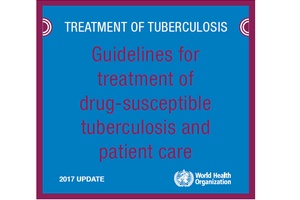Guidelines for treatment of drug-susceptible tuberculosis and patient care, 2017 update
The World Health Organization releases updated guidelines for the treatment of drug-susceptible TB and patient care.
Geneva ¦ 28 April 2017 - The World Health
Organization (WHO) released today updated guidelines
for the treatment of drug-susceptible tuberculosis (TB) and
patient care. The guidelines feature recommendations on
important developments in treatment and care which have occurred
in the past seven years, since the publication of the
previous guidelines.
“These guidelines are critical to support countries in the
provision of quality care for people with TB, and in the
implementation of the End TB Strategy”, said Dr Mario
Raviglione, Director, WHO Global TB Programme. “The new
recommendations make it clear that TB treatment must be
patient-centric, and also take advantage of digital technologies
to support care”.
Target audience
These guidelines are mainly designed for policy-makers in ministries of health or managers of national TB programmes who formulate country-specific TB treatment guidelines or who plan TB treatment programmes. In addition, all health professionals – including doctors, nurses and educators working both in government services and in nongovernmental organizations, such as technical agencies that are treating patients and organizing treatment services – are expected to use these guidelines.
Key highlights
The main updates/ highlights recommended in the guidelines include:
- The category II regimen is no longer recommended and drug-susceptibility testing should be conducted to inform the choice of the treatment regimen for patients who require TB re-treatment.
- The use of adjuvant steroids is recommended in the treatment of tuberculous meningitis and pericarditis.
- Provision of individual interventions – or a package of interventions – on patient care and support for all patients including those with drug-resistant TB. This covers patient and staff education, as well as material and psychological support.
- The use of digital health technology such as SMSes or phone calls (as a tracer option), medication monitors, and video observed treatment – as a replacement for in-person directly observed treatment – when conditions of technology and operation allow.
- Effective treatment administration options such as community or home-based treatment, over facility-based treatment.
- A decentralized model of care over a centralized model for patients on multidrug-resistant TB treatment.
“This update by WHO will greatly help inform
decision-making on the ground by national TB programme
managers, national policy-makers and medical practitioners in a
variety of geographical, economic and social settings", said Dr
Malgosia Grzemska, Coordinator, Technical, Support, Coordination
Unit at the WHO Global TB Programme. “We hope that this
guidance will serve as a one-stop shop to provide evidence-based
information on the treatment of drug-susceptible TB and
interventions to ensure adequate patient care and support for
patients with all forms of TB.”
A framework consolidating all guidelines on prevention,
diagnosis and care of TB and drug-resistant TB are planned for
release later this year.
Guidelines for treatment of drug-susceptible tuberculosis
and patient care, 2017 update
Source:
WHO


